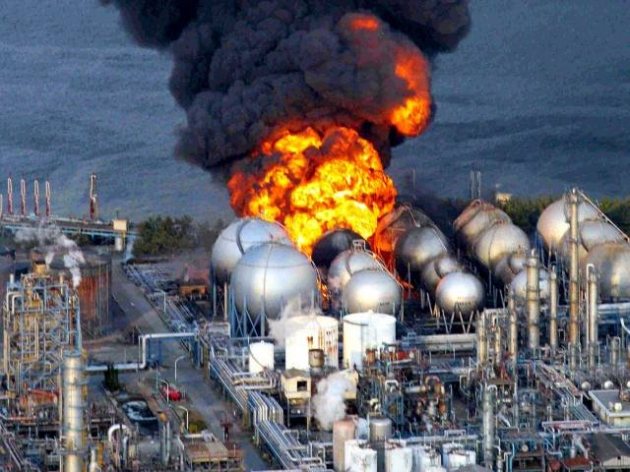There are three major sources of energy in the U.S. right now: nuclear energy, coal-based energy, and natural gas. All three operate in the same basic way, by converting water into steam which powers turbines that are connected to generators. However, the process of heating up water is very different in each case.
Nuclear Energy:
Nuclear power plants are to thank for about 20% of the U.S.’s energy today. In these plants, atoms of uranium are split through nuclear fission. Two different isotopes of uranium can be used in these plants: U-238, which is most common, and U-235. These isotopes are unstable, and when these atoms are split, the nuclei release neutrons, as well as heat energy. The neutrons that are released bump into other atoms, causing them to also release neutrons and heat energy, making a self-sustaining system. These uranium isotopes are contained in tubes that, when inserted into the system, are surrounded by water. When the heat energy is released, the heat goes into the water and converts it into steam.

(An image of a nuclear power plant as made famous on The Simpsons. Source: http://www.risefeed.com/wp-content/uploads/2015/08/Springfield_Nuclear_Power_Plant2.png)
Nuclear energy is not renewable, but it is sustainable, meaning that while there is not a limitless supply of uranium like there is sun or wind, there is enough to continue to power nuclear plants for roughly one hundred years. A very small amount of uranium can produce the same amount of energy as large amounts of coal and natural gas. There are no greenhouse gases that are emitted through nuclear fission since nothing is burned the way it is with other energy sources. What radioactive waste there is is kept contained until the radioactivity decreases enough that it can be released without harming the environment or people. Unfortunately, as nice as the pros here are, the con is that its safety is not foolproof. Chernobyl was once thought to be safe, and we all know now that that land is still unsafe to live on. More recently, the Fukushima disaster in 2011 encouraged some countries to phase out their nuclear power plants in case some similar emergency could occur there, but the U.S. continues to heavily rely on nuclear power with no intention to stop.
Coal:
Coal is burned, creating the heat that allows water to change into the steam that powers the generators. The coal is first ground into a fine powder, allowing it to burn more quickly and at a hotter temperature. The diagram below shows exactly how coal becomes electricity in the ways I have already described:

(How coal is burned to power generators. Source: http://www.worldcoal.org/media/jpg/585/174139cgart.jpg)
Coal has been the basis of the energy in this country for generations and is still used heavily, although recently companies have been working to make their systems more efficient so that the same amount of coal can produce more energy and fewer byproducts such as CO2 and other greenhouse gases. Newer systems are also planning on being fitted with CO2 capture systems which can help filter carbon dioxide and prevent it from entering the atmosphere. Although this energy system has been around for ages, today there is much work being put into modernizing it to help cut costs and pollution, two of the biggest concerns about relying on coal-powered energy.
Natural Gas:
Natural gas occurs from plants and animals that have died and decomposed thousands of years ago. The energy that they had gained from the sun is contained in the form of carbon in natural gas. This natural gas is a fossil fuel that is harvested through the process of fracking, something I have already explained in an earlier blog post. Once the natural gas is available for use, it is treated for impurities so it can be made more efficient, and then it can be converted into usable energy in two different ways. As in the case of coal, natural gas can be burned to produce steam from water and the steam powers turbines which in turn power generators. Another system in use is bypassing the water entirely and just burning natural gases in a combustion turbine which directly produce electricity. Recently it was discovered that it is possible to use these two systems at the same time, so that steam and gas vapors are both used to power turbines, resulting in the same amount of gas being used twice and producing twice the amount of energy.

(The path of natural gas form its source to the consumer of its produced energy. Source: https://www2.dteenergy.com/wps/wcm/connect/08d8250d-ff32-4b69-aee3-d3552d45f240/naturalGasIndustry.gif?MOD=AJPERES&CACHEID=08d8250d-ff32-4b69-aee3-d3552d45f240)
Burning natural gas does produce fossil fuels like NO and CO2, but it produces these in smaller quantities than the burning of coal does, for example. Methane can leak out in a few places during the process of harvesting, transporting, or burning as well. Minimal solid waste is produced from burning natural gas, but that should not suggest that this is a harmless energy source. Fracking can destroy agriculture, natural habitats, and communities, even when done correctly and carefully. Harvesting coal is much safer, as is mining uranium when done properly.
All sources have positive elements but troublingly they also all have seriously negative elements. It is important to remember that these three sources, while the biggest sources for energy in the U.S., are not the only available options. Solar energy and wind energy are just two of the increasingly popular renewable and clean energy sources we have available today, and neither of those are nearly as harmful as fracking has been in Appalachia or nuclear energy has been in Japan.
Sources:
http://www.nei.org/Knowledge-Center/How-Nuclear-Reactors-Work
http://www.worldcoal.org/coal/uses-of-coal/coal-electricity/
http://www.epa.gov/cleanenergy/energy-and-you/affect/natural-gas.html








